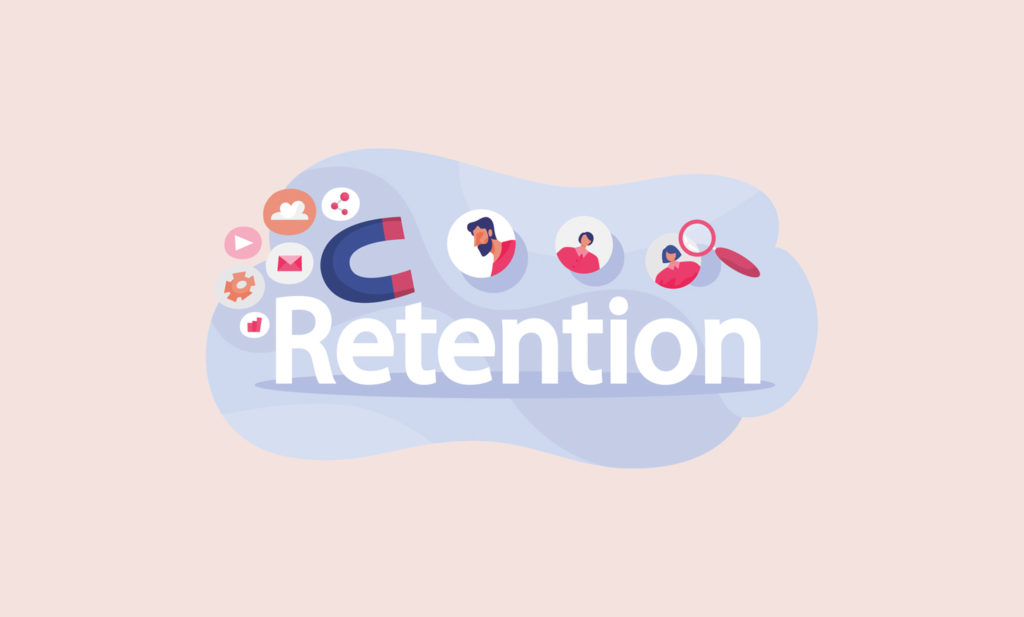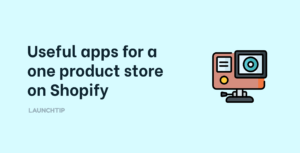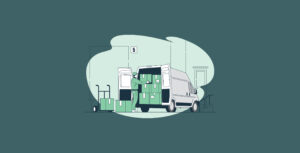Last Updated on by Dan S
Originally Published June 25, 2021.
You’ll probably trying to remember the last time you re-engaged with your customers to get them back to purchase again. If you’re struggling, now is the time to start creating a new customer retention strategy.
Customer retention is extremely important and is an underrated growth tactic that numerous businesses fail to grasp. It’s mad to think that just a 5% increase in your customer retention can surge your profit by up to 95%. If you’re in a super competitive industry, ensuring your current customers return to your store will generate you a higher ROI than getting new customers on board.
We want to provide you with a powerful retention strategy that will deliver you actual results. Read on to find out how to retain customers.
Table of Contents
ToggleWhat is customer retention?
Customer retention is actioning a business takes to increase their repeat customers along with the profitability of each current customer.
You want to persuade one-time consumers to become regular shoppers on your store. Customer retention is there to maximize the value of your current customers.
When should I focus on customer retention?
To ensure your customer retention strategy works, you’ll also need an acquisition strategy in place. You’ll need to decide how much time you want to spend on each part of your business and which strategy. This will depend on your online store’s customer lifecycle.
If you’re a new business, you need to focus on acquisition. You can’t work on retaining customers if you have none in the first place.
As your business starts to grow and you onboard new customers, you can begin to think about easy and simple retention strategies to get those customers back to your store. This could be something as simple as a retention email flow.
Once your business evolves further, you can shift your focus equally between your acquisition and retention strategies. You might want to look into creating a loyalty or rewards program that will influence new customers to your store and get your current customers to return.
When you’ve got to the point where your business is fully established and it’s achieved steady growth, you can switch your main focus to retention. However, don’t stop acquisition. You’ll still need this to replace any churning customers.
With all this said, some business industries will need to focus more on retention than others.
Which industry needs to focus more on customer retention?
Nearly every business needs to have a retention strategy. But those businesses with a higher purchase frequency will get the most out of a superb retention strategy.
Industries and businesses that sell the following products need to focus on acquisition include:
- Furniture
- Home appliances
- Vehicles
- Phone cases & accessories
If your business sells the following products, you’ll need to focus on retention:
- Electronics
- Fashion
- Office supplies
- Pet supplies
- Coffee
If you’ve got a business that focuses on retention, this is because the products your store sells are items that consumers change or replace on a regular basis. Businesses that focus more time on acquisition sell products that have a longer life. For example, a sofa. Consumers are less likely to change or buy a new one regularly, so obtaining new customers is critical for this type of business to survive.
Whichever category your business fits into, you don’t want to lose sight of the other objective, whether it’s acquisition or retention. As a business, you’re always going to need to obtain new customers; you just need to focus and balance your priorities.
4 Customer retention benefits
Obtaining new customers and getting them interested in your business is such an awesome feeling. But we all know that returning customers is what makes the money. Let’s discuss in some detail the benefits of customer retention and why it’s so important.
1. Use customer retention to boost your profit
Let’s use an example to make it super easy to understand. You spend $20 acquiring a customer from Google Ads. The customer goes on to spend $25 on your store. You’ve made a small profit of $5.
Now it gets interesting. If you send the same customer a marketing email at a cost of $0.001c to encourage them back to your site to make another purchase of $25, then your profit margin has increased dramatically. By getting customers to return to your store and make further purchases, you’ll draw in more revenue and spend less with marketing.
2. You can spend more than your competitors
If you can maximize the value of current customers by getting them return to your store to make further purchases, this allows you to spend more acquiring new customers. It’s a repeated process. You make the most out of a customer that then allows you to obtain more.
For your competitors that don’t focus on retention and pay high amounts on getting new customers, it’s their loss. With you spending time on retention, you can outbid your competitors for new customers, as your current customers are spending enough.
3. Retaining current customers is much easier than acquiring new ones
This does make a lot of sense. Your current customers already know who you are and what you sell. If they’ve already purchased from you, then there shouldn’t be a reason as to why they wouldn’t buy again.
4. Customer retention is a ‘cheap’ way to market
There are probably numerous brands that make you feel a valued customer, and because of this, you’d be more than happy to recommend that company to your friends or family? Having an excellent retention strategy in place is key to reducing your acquisition costs and word of mouth plays into this. It costs nothing.
If you have brand advocates selling your brand for you, your company will grow quickly and you can look forward to great profits with no marketing costs.
By focusing on the four points above, it should definitely help to shift your focus to customer retention.
How to measure customer retention
For a retention strategy to work well, you need reliable data. This is so important if you are looking to track certain retention metrics as a way to improve your business.
Read on to see which retention metrics you should be measuring.
1. Repeat customer rate (%)
Repeat customer rate (%) is probably the most standard and important metric you should be tracking if you’re looking to get good customer retention. It’s super easy to calculate; just take the number of your repeat customers and divide them by your total number of customers.
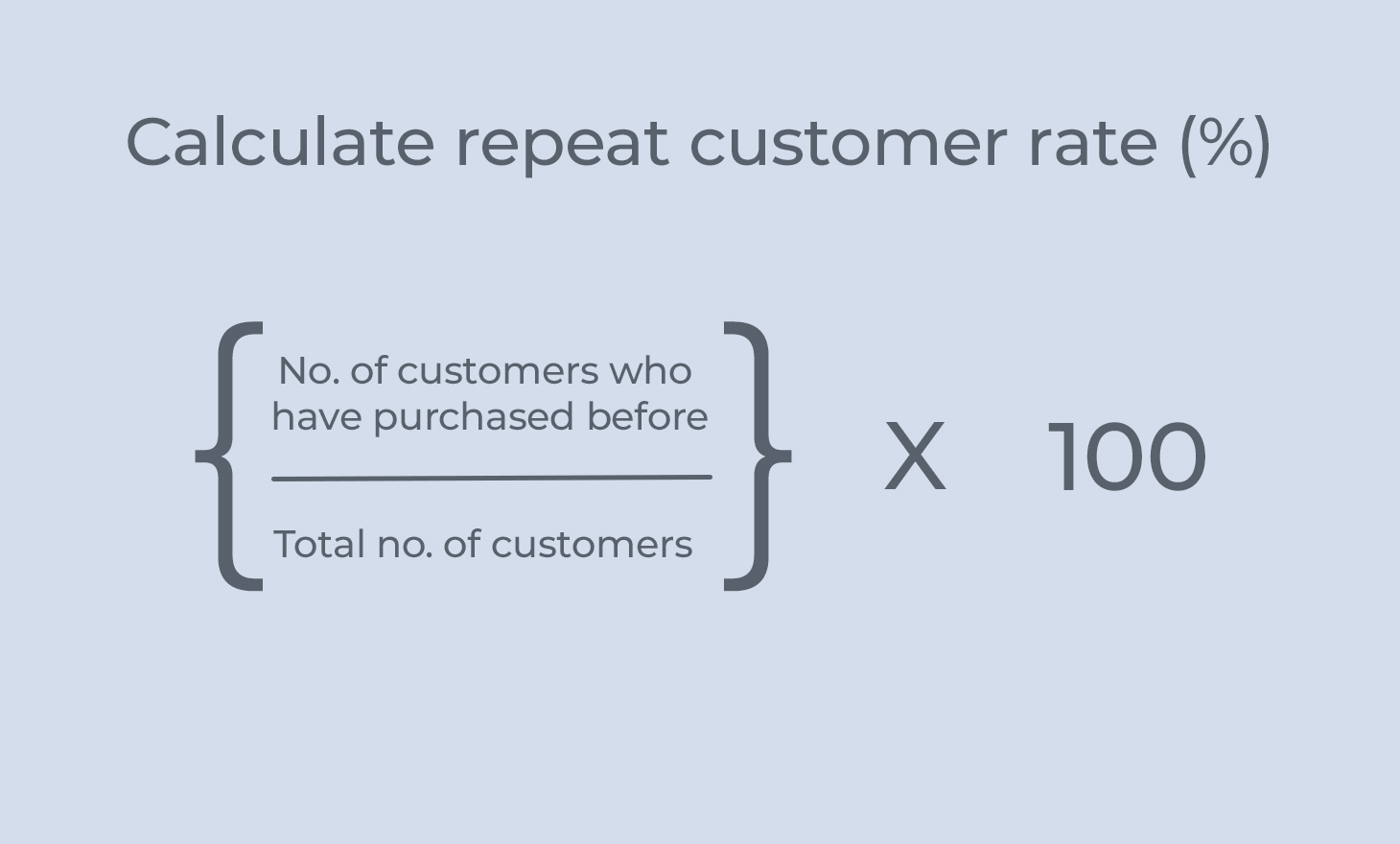
Your repeat customer rate will help you understand where you are at the moment. From this, you can then go on to make improvements. Tracking your customer rate over a period of time will allow you to see if your retention efforts are paying off.
If you use Shopify, you can find your repeat customer rate in your admin dashboard. It’ll be noted as a percentage. The higher the percentage means your customers are returning and the lower the percentage indicates your sales are from first-time buyers.
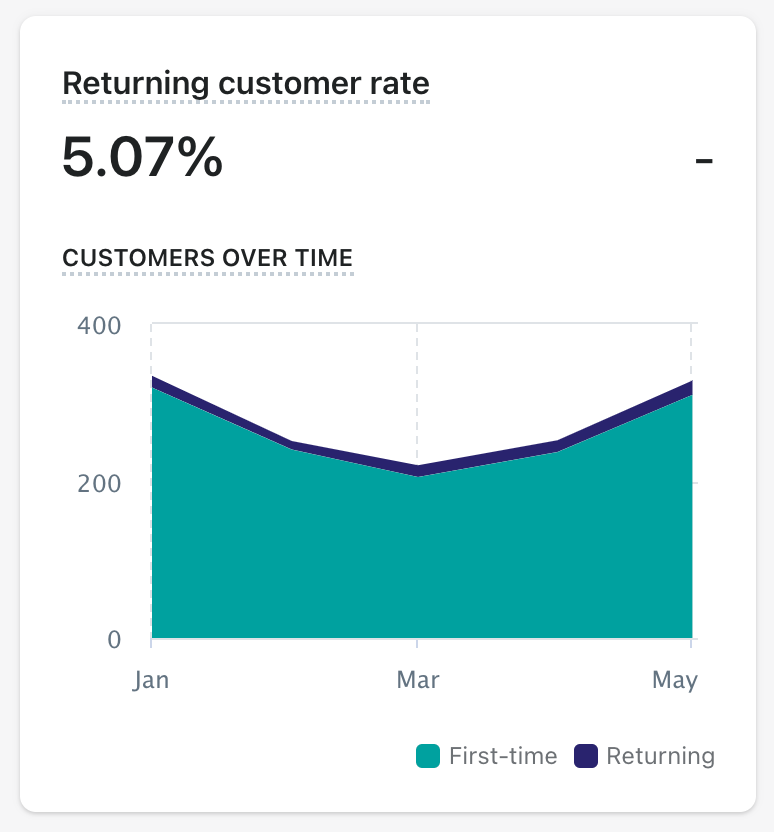
2. Purchase frequency of your customers
This indicates how often your customers are returning to purchase goods from your store.
It can easily be calculated by taking the number of unique customers visiting your store and dividing them by the number of orders placed in a given time (such as a week, month or quarter).
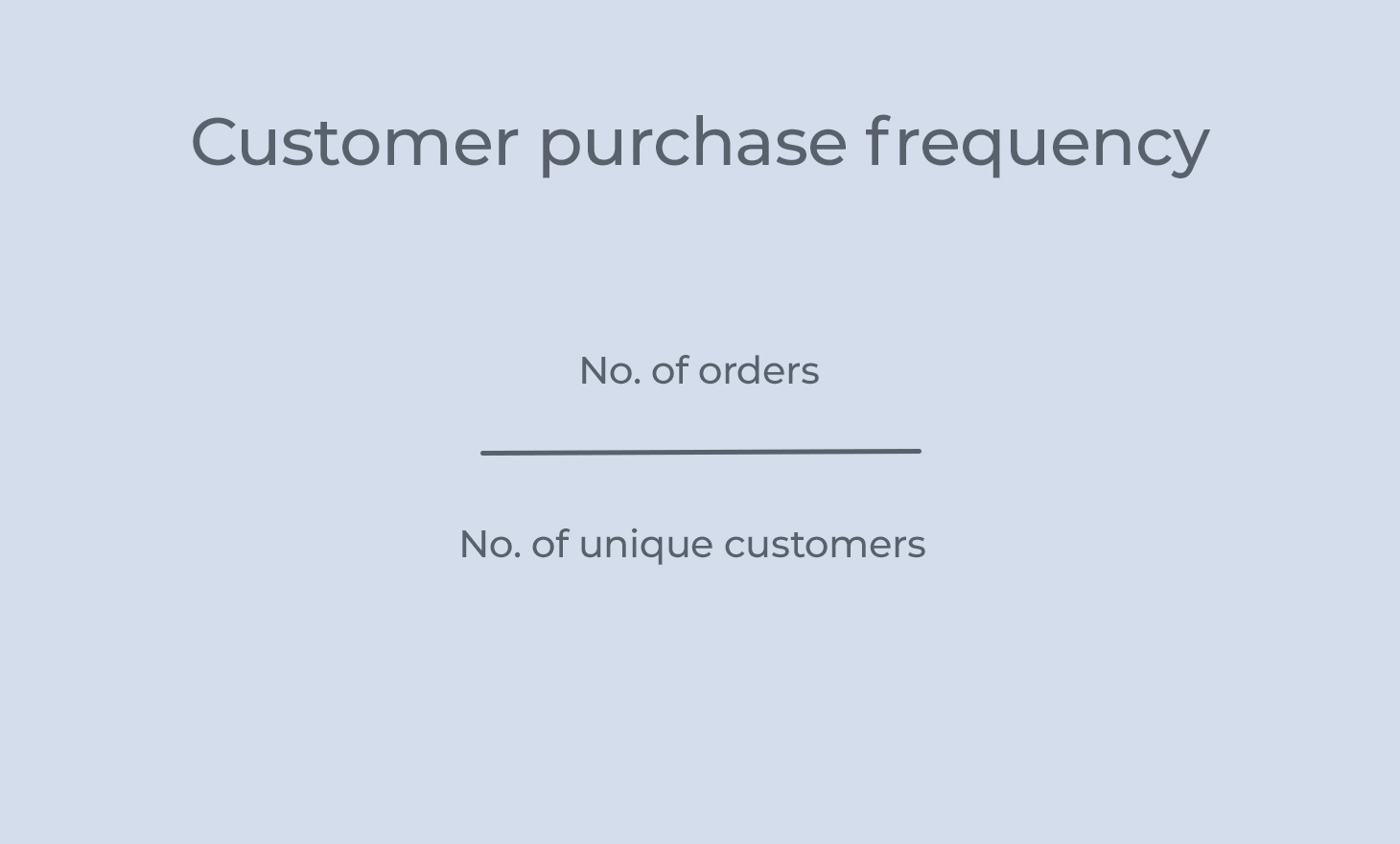
This will help you to understand your customers’ purchasing behaviour. You can then plan and create retention strategies based on the information you calculate.
3. Average order value
When you know your customer returning rate, you can start to work on the next metric; your average order value. This is very important, as the higher your average order value, the more revenue you make.
If you can get repeat customers to increase their order value by purchasing more than one product, it’s a simple way to bring in more revenue to your store. You could even look into creating a loyalty program for your super customers.
To calculate your average order value, divide the number of orders by your total revenue. If you use Shopify, you can find this figure in your analytics dashboard.
4. Customer value
Customer value calculates how much profit the average customer produces for your store over a given period of time.
The easiest way to calculate your customer value is: (Average order value x Customer repeat rate) – Customer acquisition cost
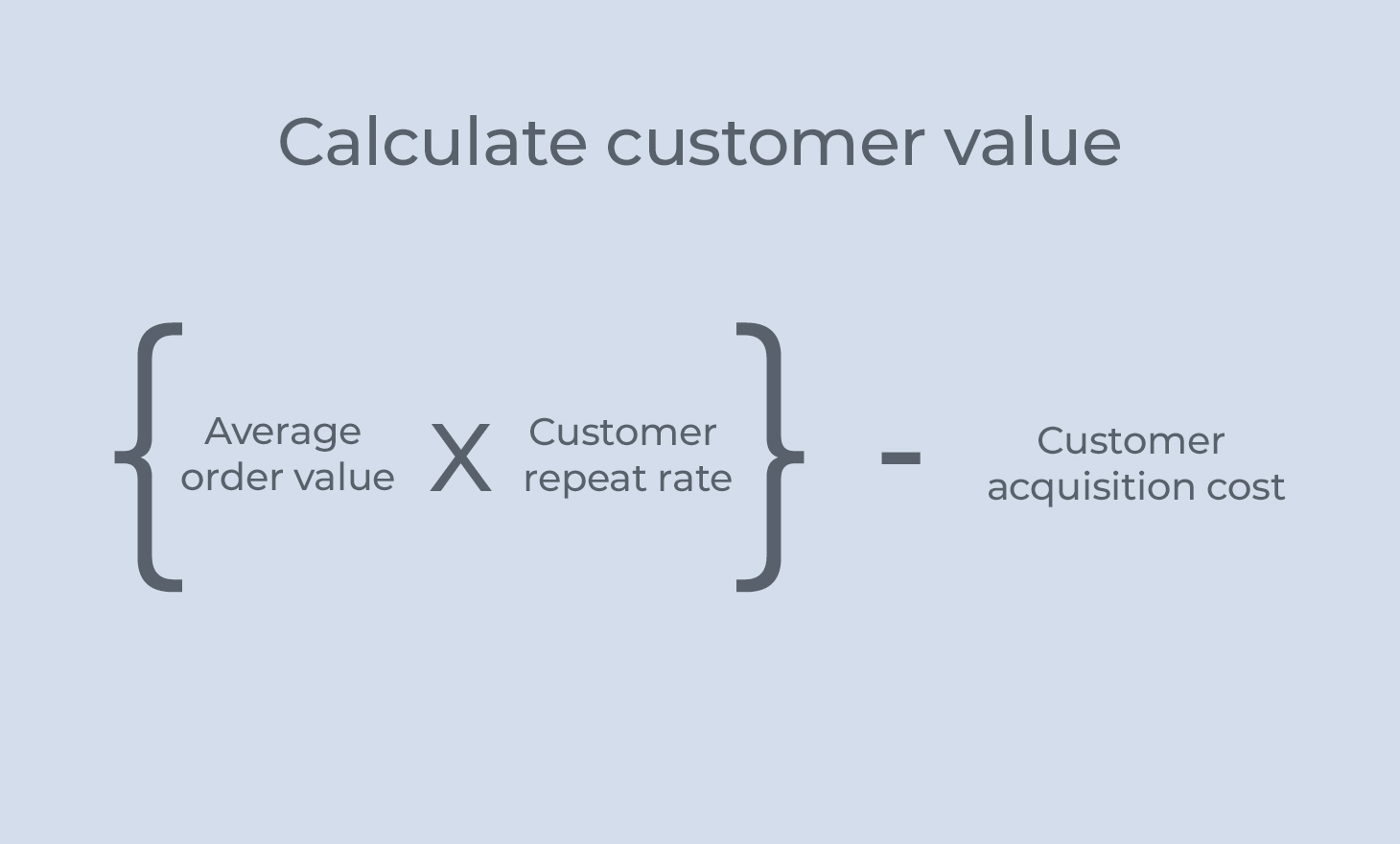
If you have a low customer value, then you’ll need to take a look at your retention strategy and see what you can do to make quick improvements. Take time to improve your customers’ satisfaction and experience on your store.
5. NPS (Net Promoter Score)
NPS allows you to track how likely your customers are to recommend your brand to others. In order to produce a net promoter score, you’ll need to ask your customers questions and get data from them via emails or SMS, for example.
Your customers will then answer the questions using a ten-point scale, on how likely they are to recommend, based on each question. For example, ‘very unlikely’ to ‘highly likely’.
The scale is split into three sections:
9 or 10 = promoters
7 or 8 = passive
1 – 6 = detractors
You calculate your NPS by subtracting the % of detractors from the % of promoters.
NPS = promoters – detractors
The score will give your an understanding of how people rate and feel about your business and brand. It means you can learn where your biggest improvements need to be.
5 strategies you can try to improve your customer retention
Now you’ve read all of the above, you should have grasped a good understanding of customer retention, why it’s important and what you need to do.
Read on to see five customer retention strategies we think you should try.
1. Leverage your ‘Thank you’ page
The ‘Thank you’ page on your store is one of the most under-utilised pages.
This is one of the first chances you have to show new customers what your brand is all about. Essentially, ‘thank you’ pages have a 100% open rate, which is more to say than email open rates.
We suggest giving your ‘thank you’ page an overhaul. Include your logo, images and perhaps a video, showcasing your brand to your customers. Make them feel welcome and part of your community from the get-go.
It’s also a great place to ask for feedback. Find out how your customers found the buying process on your store. It’s a positive place to ask for the customer’s birthday or other preferences, whilst they’re still in a good state of mind. This can allow you in the future to segment your customers for precise marketing campaigns.
Don’t forget that you could also be offering post purchase offers here too. You could easily turn a new customer into a repeat customer that quickly. Use a well thought-out upsell to encourage them to purchase immediately again.
Amazon is a company that definitely uses this tactic to sell other products immediately after a customer has just purchased.
2. Create a rewards or loyalty program
Everyone is aware of those unique coffee shops where you can get your tenth drink for free. Consumers are more likely to return to a store if there is a customer rewards or loyalty program in place.
Ideas could include redeemable points. For example, for every $1 a customer spends on your store, they receive 1 point. They can then redeem these points. Offer birthday gifts and discounts on your customers’ birthdays.
There are many rewards and loyalty apps on Shopify. Take a look at our top four referral and loyalty apps.
3. Send out customer retention emails
You know by now that email marketing is an extremely powerful way to keep your customers engaged with your store. Email marketing has proven to have the highest conversion rate of any marketing channel.
When looking at retention emails, you need to ensure that you offer your customers with value. There’s no point just endlessly sending them spammy emails with low-quality offers. This is where segmentation of your customers can help.
As well as sending offers, it can be good to send other emails too, such as informative and interesting content from your blog, for example.
If you need some ideas to get you started, consider these:
- Emails sent on birthdays or public holidays etc
- Anniversaries relating to your customers, for example, one or two year anniversaries spent shopping with your store
- Milestones that your company reaches. For example, you’ve been in business for over 2 years
- Early access emails where customers can discover new products before others
- Exclusive discounts and offers. Give 25% off to your customers for being great, for example
4. Cleverly ask customers to create accounts
Customer accounts on your store are a great thing to offer.
Accounts can make it so much easier for customers to manage their orders and purchase again. However, not all first-time buyers want to create accounts. It can even have a negative impact on conversion rate if customer accounts are made mandatory.
We suggest letting customers check out on your store as ‘guests’. After, you can offer them the option to create an account.
As well as suggesting to create an account after customers have checked out, you could send them an invitation via email to create an account.
5. Give your customers the support they want
Customer support is extremely important when you provide a product or service. Customer support is not just about solving customers’ issues; it’s about going above and beyond to help the customer and get them to purchase and return to your store.
Here are some top tips to provide excellent customer service:
- Ensure your customers can easily contact you. No one likes to struggle to contact a company. Find out which support channels are best for your customers, and use them. These channels could include email, calling or Facebook Messenger.
- Create a thorough FAQ page. Many customers like to self-serve and work things out on their own. Having an informative and easy to read FAQ section on your website will help with this.
- Customers love to feel part of your brand. Find ways to give back to your customers. Including gifts in orders and doing social media shoutouts can make your customers feel welcomed and wanted. There’s nothing better than turning your great customers into brand advocates.
Retain more of your customers
Your customers are one of your greatest assets in your business.
It’s a no brainer that higher customer retention rates will increase your revenue. You’ll be able to watch your profits soar.
Let’s quickly recap on the customer retention strategies we suggested:
- Make the most of your ‘thank you’ page after a customer has checked out. It’s the first time they’ll really get to see what you brand is about
- Create great rewards and loyalty programs that your customers will want to be part of
- Send your customers fantastic retention emails. Give them gifts and discounts to keep them returning
- Try to get your customers to create accounts on your store
- Give your customers excellent customer service
Customer retention is all about creating a fantastic shopping experience that they’ll want to return to. When you make a positive impression with a customer, they’re more likely to return to your store and purchase again.


